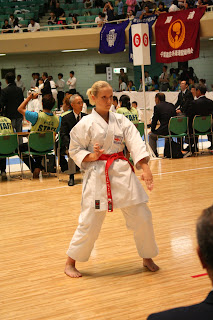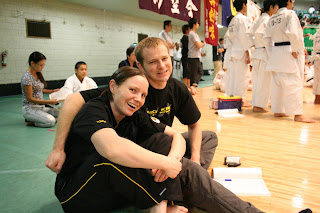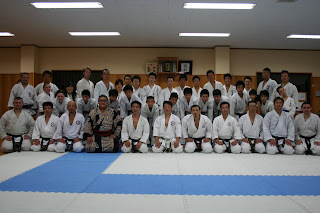
Pete here,
September was the beginning of the Autumn term for schools, and a welcome return to my routine after the often chaotic pace of the Summer 'Holiday'. The return to the Lolipop Kindergarten on Friday in particular was punctuated by being immediately set upon by the kids, who must've missed their walking-climbing frame during the break. Touching!
My weekly schedule has an essential structure, with some extra lessons/days in school happening periodically.
MONDAY
Morning: Shirayuri Kindergarten
I go with the bus to greet the kids in English as they board, then in school I do three 15-20 minute lessons for the different classes. Usually this is singing, basic words and actions (head/shoulders/knees/toes etc.), however up until the middle of October I will be helping them prepare for their Sports Festival (by dancing and marching like a lunatic, mostly)
Afternoon: Shiramizu English Class
I teach one hour at the Shiramizu English Club, in the hut next to the dojo. Most of the kids at the club have had at least one previous Intern teach them, so their English is much more advanced than at the kindergarten, or with other kids their age. The songs are more complicated, and they get to use more constructed sentences, and even ask questions!
Evening: Shiramizu English Class
I teach Setsuko, our adult English Student and #1 Intern supporter throughout the years. Recently I have also taught her some German!
TUESDAY
Morning: Shirayuri Kindergarten
This is the same as Monday. Sometimes Arakawa Sensei also comes to the school and teaches the kids 30 minutes of Karate per class, and I act as assistant- very very fun!
Afternoon: Shiramizu English Classes
Tuesdays I teach 3 classes, each with different age and abilities. It certainly keeps your brain active trying to come up with ways to teach! These classes run right up until Karate training in the evening.
Evening: Training
The first Adult training session of the week.
WEDNESDAY
Morning: Training
Training starts at 10:30 so there's plenty of time to get up and ready for the day. This session is usually slower paced than the evening sessions and more care is taken to explain the techniques. This of course changes when a tournament is approaching, or if the kids are on holiday. This training is almost always followed by lunch together; a very important part of the social calendar!
Afternoon: Shiramizu English Class
This one hour class is quite late in the afternoon, so I get a few hours after lunch to prepare and plan for the rest of the day.
Evening: Adult Conversation Class
This is a new one for the Autumn- a weekly hour-long session with over 20 adults! This was quite scary at first, but now after the third lesson I'm getting into the swing of it, with some 'genki' banter as well! this is only for ten weeks, so the course will finish in November.
THURSDAY:
All Day: I.C.E, Nerima
I.C.E. is a private School that provides, amongst other things, english conversation classes. I teach 5 lessons to kids between 6 and 12 and one Adult. This is a great job as the location means i can catch a bit of the Tokyo atmosphere during lunch, and after work. I often spend just a little longer than usual getting home as I stop in a noodle bar for some food and check out Ikebukuro or Shibuya.
FRIDAY:
Morning-early Afternoon: Lollipop Kindergarten
Possibly my favourite job! I get picked up by the School Bus at Himemiya Train Station and essentially get to play with the kids until lunchtime, then afterwards take 15-20 minute lessons. These days are almost always fun, and the kids are adorable here. Sometimes they have special activities arranged, like painting and the teachers and I hang them outside to dry, making a beautiful marquee.

Afternoon: Shirayuri English Club
For two hours I teach kids from 3 to 6 years old. This is mainly things that I cover in the lessons earlier in the week, but in more detail. Sometimes the very young kids get really tired so it can be a little tricky to get them motivated, but usually a game or song wakes them up a little! The older kids are amazingly switched on though, so it's great to teach them.
Evening: Karate, support and Training
After Shirayuri I get an hour or so to eat and unwind, then I help Arakawa sensei with his evening elementary class. This involves correcting stances, footwork and explaining things when I can!! After this class is the junior High School class and I train with them, they're certainly good enough to put me to shame so I get what I can from them.
WEEKEND:
I only have one commitment, and that's Adult training on Saturday evenings. Usually though, I do find that I've agreed to be part of some event or other, so I'm never kicking my heels and it's great to feel like I'm really part of something. However, I do use some of this time to do the more mundane tasks like shopping and washing. Some things never change no matter where in the world you are!
My weekly schedule has an essential structure, with some extra lessons/days in school happening periodically.
MONDAY
Morning: Shirayuri Kindergarten
I go with the bus to greet the kids in English as they board, then in school I do three 15-20 minute lessons for the different classes. Usually this is singing, basic words and actions (head/shoulders/knees/toes etc.), however up until the middle of October I will be helping them prepare for their Sports Festival (by dancing and marching like a lunatic, mostly)
Afternoon: Shiramizu English Class
I teach one hour at the Shiramizu English Club, in the hut next to the dojo. Most of the kids at the club have had at least one previous Intern teach them, so their English is much more advanced than at the kindergarten, or with other kids their age. The songs are more complicated, and they get to use more constructed sentences, and even ask questions!
Evening: Shiramizu English Class
I teach Setsuko, our adult English Student and #1 Intern supporter throughout the years. Recently I have also taught her some German!
TUESDAY
Morning: Shirayuri Kindergarten
This is the same as Monday. Sometimes Arakawa Sensei also comes to the school and teaches the kids 30 minutes of Karate per class, and I act as assistant- very very fun!
Afternoon: Shiramizu English Classes
Tuesdays I teach 3 classes, each with different age and abilities. It certainly keeps your brain active trying to come up with ways to teach! These classes run right up until Karate training in the evening.
Evening: Training
The first Adult training session of the week.
WEDNESDAY
Morning: Training
Training starts at 10:30 so there's plenty of time to get up and ready for the day. This session is usually slower paced than the evening sessions and more care is taken to explain the techniques. This of course changes when a tournament is approaching, or if the kids are on holiday. This training is almost always followed by lunch together; a very important part of the social calendar!
Afternoon: Shiramizu English Class
This one hour class is quite late in the afternoon, so I get a few hours after lunch to prepare and plan for the rest of the day.
Evening: Adult Conversation Class
This is a new one for the Autumn- a weekly hour-long session with over 20 adults! This was quite scary at first, but now after the third lesson I'm getting into the swing of it, with some 'genki' banter as well! this is only for ten weeks, so the course will finish in November.
THURSDAY:
All Day: I.C.E, Nerima
I.C.E. is a private School that provides, amongst other things, english conversation classes. I teach 5 lessons to kids between 6 and 12 and one Adult. This is a great job as the location means i can catch a bit of the Tokyo atmosphere during lunch, and after work. I often spend just a little longer than usual getting home as I stop in a noodle bar for some food and check out Ikebukuro or Shibuya.
FRIDAY:
Morning-early Afternoon: Lollipop Kindergarten
Possibly my favourite job! I get picked up by the School Bus at Himemiya Train Station and essentially get to play with the kids until lunchtime, then afterwards take 15-20 minute lessons. These days are almost always fun, and the kids are adorable here. Sometimes they have special activities arranged, like painting and the teachers and I hang them outside to dry, making a beautiful marquee.

Afternoon: Shirayuri English Club
For two hours I teach kids from 3 to 6 years old. This is mainly things that I cover in the lessons earlier in the week, but in more detail. Sometimes the very young kids get really tired so it can be a little tricky to get them motivated, but usually a game or song wakes them up a little! The older kids are amazingly switched on though, so it's great to teach them.
Evening: Karate, support and Training
After Shirayuri I get an hour or so to eat and unwind, then I help Arakawa sensei with his evening elementary class. This involves correcting stances, footwork and explaining things when I can!! After this class is the junior High School class and I train with them, they're certainly good enough to put me to shame so I get what I can from them.
WEEKEND:
I only have one commitment, and that's Adult training on Saturday evenings. Usually though, I do find that I've agreed to be part of some event or other, so I'm never kicking my heels and it's great to feel like I'm really part of something. However, I do use some of this time to do the more mundane tasks like shopping and washing. Some things never change no matter where in the world you are!


















































